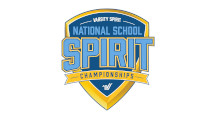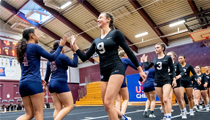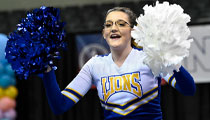2014-15 Spirit Rules Changes Focus on Minimizing Risk During Inverted Stunts
By on July 23, 2014 spirit article PrintThe National Federation of State High School Associations (NFHS) Spirit Rules Committee adjusted several rules with the goal of minimizing risk and increasing creativity during its March 8-10 meeting in Indianapolis. The recommended rules changes were subsequently approved by the NFHS Board of Directors.
The committee approved the conditions for performing an inverted stunt during partner stunts and pyramids. According to Rule 2-5-2, the base person must keep contact with the top person enough to stabilize the top person. An exception to this is that an inverted top person in a handstand on the ground can be released to a loading person below shoulder height.
In addition, according to Rule 2-5-2b, inverted partner stunts must begin and end below an extended position and can be performed by passing through an extended position without pausing or stopping. Previously, the base person was not allowed to extend arms to perform an inverted stunt.
“Inversions have become a common element in cheerleading. The changes to Rule 2-5-2 will reduce confusion among coaches, interpreters and judges,” said Kent Summers, NFHS director of performing arts and sports and liaison to the Spirit Rules Committee. “The committee wants to promote better technique in performing and teaching the stunts, which can allow greater creativity without adding undue risk to participants.”
The information included in Rule 2-5-3, involving suspended rolls, was incorporated into Article 2 and will follow the same rules as other inverted partner stunts. To reduce the risk to performers, single-based suspended rolls require a spotter to aid in the transfer of the top person. Now, the new catcher must be in place and not involved in any other skill when the suspended roll is initiated.
Another rule change approved by the committee restricts an inverted top person from holding any object. With the addition of Rule 2-5-4, poms, signs, etc. are prohibited while performing a stunt from the inverted position.
“Because the hands of an inverted top person are frequently close to the heads and faces of ground-level participants, allowing the top person to hold objects creates additional risk we do not want while the top person is in an inverted position. This revision will help minimize risk,” Summers said.
With changes made to Rule 2-3-8, participants may wear supports, braces, soft casts, etc., as long as they have not been altered from the manufacturer’s original design. If altered, padding should be provided with closed-cell, slow-recovery foam padding no less than one-half inch thick if the participant is involved in partner stunts, pyramids or tosses. Plaster casts and walking boots are not permitted for partner stunts, pyramids or tosses.
A new rule was put in place to reduce the risk of injury to students. According to Rule 2-9-9, during a dismount to a new catcher, the catcher must remain close to the original base. The catcher cannot be involved in any other stunt when the release is initiated.
In addition to the official rules changes, the committee added “Lift” to the “Stunt/Partner Stunt” definition, as well as adding “Foldover Stunt.” Changes were made to the previous “Forward/Backward Roll,” “Suspended Roll/Flip” and “Tumbling” in the definitions section. Final changes involved the deletion or editing of specific “Notes.”
A complete listing of all rules changes will be available on the NFHS Web site at www.nfhs.org. Click on “Athletic Activities” in the sidebar menu on the home page, and select “Spirit.”
According to a survey of NFHS-member state associations in 2009, there are about 400,000 high school cheerleaders in the United States, including 116,508 who are involved in competitive spirit squads, which ranks ninth among girls sports according to the 2012-13 High School Athletics Participation Survey conducted by the NFHS. There are also about 29,500 girls who participate in dance or drill teams, according to the same survey.
Most Recent Articles
- nfhs news NFHS Learning Center Delivers 25 Millionth Course
- Track & Field/Cross Country article Effective Communication with Athletes and Coaches
- nfhs news Player Equipment Changes Highlight 2025 High School Football Rules Revisions
- Player Equipment Changes Highlight 2025 High School Football Rules Revisions
- nfhs news Judgment Call on Second Contact Eliminated in High School Volleyball







